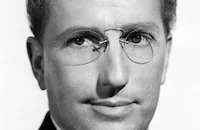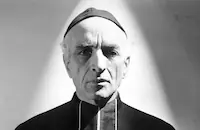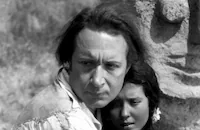Humoresque

Brief Synopsis
Cast & Crew
Jean Negulesco
Joan Crawford
John Garfield
Oscar Levant
J. Carrol Naish
Joan Chandler
Film Details
Technical Specs

Synopsis
After renowned violinist Paul Boray cancels his New York City performance, he tells Frederick Bauer, his manager, how much he wishes he were still the simple, happy child that he used to be: Paul first becomes interested in the violin as a child on New York's East Side in 1920 and chooses the instrument, rather than a toy, for a birthday present. Encouraged by his mother Esther, Paul becomes proficient and attends music school. During the Depression of the 1930s, the family grocery store suffers. Phil, Paul's older brother, who is out of work, resents the fact that Paul spends his time practicing instead of working. Wounded by his brother's comments, Paul gets a job with a radio orchestra with the help of his friend, pianist Sid Jeffers, but is fired when he objects to the station's policy of cutting compositions to fit into an allotted time. Paul then decides that he is ready to make his concert debut. Sid suggests that he attend a party at the home of socialites Helen and Victor Wright, where he might meet people who will help him financially. Despite Paul's surly attitude, Helen is intrigued by his talent and offers to help him become established as an artist. She introduces him to Bauer and pays for his first public recital. Afterward, Paul's family has a small party in his honor, which he misses because he is celebrating with the Wrights. Esther warns Paul not to become involved with Helen and reminds him about Gina, a fellow student, who loves him. With Helen's aid, Paul becomes a successful performer, and eventually, he and Helen fall in love. When Victor offers Helen a divorce, she hurries to the hall where Paul is rehearsing to tell him, but he refuses to interrupt the rehearsal to talk to her. Helen feels that his dedication is a rejection and, as she often does, eases her pain by drinking. Later, Paul and Helen are reconciled and make plans to marry. Helen then attempts to make peace with Esther, who reminds Helen about her three previous marriages and begs her to consider the effect her drinking and need for attention will have on Paul's career. One night, while Paul performs on the radio, a drunken Helen realizes that she will never mean as much to Paul as his music and walks into the ocean to her death. Paul is devastated and cancels his concert appearances, but now knows that he must go on with his music.

Director

Jean Negulesco
Cast

Joan Crawford

John Garfield

Oscar Levant

J. Carrol Naish

Joan Chandler

Tom D'andrea
Peggy Knudson
Ruth Nelson

Craig Stevens

Paul Cavanagh

Richard Gaines

John Abbott

Bobby Blake
Tommy Cook

Don Mcguire

Fritz Leiber
Peg La Centra

Nestor Paiva
Richard Walsh
Sylvia Arslan
Ann Lawrence
Charles Kenworthy
Gary Armstrong
Creighton Hale
Leah Baird
Louis Quince
Leo Wonder

Monte Blue
Ramon Ros
Janet Barrett
Jane Harker
Edward Harvey

Angela Greene
John Walsh
Esther Michelson
Frank Elliott
Danny Dowling

Patricia White

Paul Panzer
Joe Smith
Don Turner
Crew
Adrian
Eddie Allen
Johann Sebastian Bach
Della Barnes
Lou Baum
Georges Bizet
Johannes Brahms
Ralph Burbank
Paul Butler
Herschel Daugherty
Roy Davidson
Mary Deery
Antonín Dvorák
Alma Dwight
Rudi Fehr
Leo F. Forbstein
David Forrest
César Franck
James Geldenhar
George Gershwin
Ira Gershwin
Zachary Gold
Herbert S Greene
Edvard Grieg
Ernest Haller
Ralph Hibbs
Édouard Lalo
Robert B. Lee
James Leicester
Felix Mendelssohn
John Mitchell
Bernard Newman
Clifford Odets
Cole Porter
Sergei Prokofiev
Phil Quinn
Hugh Reticker
Pablo Sarasate
William Schurr
Dmitri Shostakovich
Clarence Steenson
Isaac Stern
Jeanette Storck
John Strauss
Peter Ilyich Tchaikovsky
Vic Vallejo
Willard Van Enger
Richard Wagner
Jerry Wald
William Wallace
Jack L. Warner
Franz Waxman
Perc Westmore
Gertrude Wheeler
Henryk Wieniawski
Levi C. Williams
Jack Woods
Stanley Young

Photo Collections
Videos
Movie Clip




Trailer
Hosted Intro
Film Details
Technical Specs

Award Nominations
Best Score
Articles
Humoresque
Joan Crawford, Humoresque (1946)
However her character may have felt in this 1946 romantic drama, on-screen Joan Crawford played second fiddle to nobody. Although John Garfield had the larger role, as a ghetto boy who rises to fame and fortune as a classical violinist, Crawford dominated the film. From her first appearance, fending off a circle of admirers all trying to light her cigarette, to her final scenes as she walks into the ocean to save Garfield's career, the film showcased Crawford in one of her most complex roles.
Humoresque was adapted from a Fannie Hurst short story that had been filmed as a silent in 1920. The 1946 version was inspired less by a desire to remake her classic tearjerker than by Warner Bros.' need to get something out of a very expensive and lengthy screenplay Clifford Odets had written for Rhapsody in Blue, their musical biography of composer George Gershwin. The Odets take on his story was good, but a little heavier on social commentary than they'd planned. But his story of a slum boy whose musical talents are exploited by the wealthy had potential, so producer Jerry Wald matched it with Hurst's similar tale to create a vehicle for John Garfield.
Odets had created a particularly strong characterization for the role of Helen Wright, a wealthy neurotic who sponsors the violinist's career in hopes of making beautiful music with him. Wald considered such luminaries as Tallulah Bankhead and Barbara Stanwyck for the part. When Crawford -- who was generating a lot of buzz with her first Warners' film, Mildred Pierce (1945) -- expressed an interest in it, Wald jumped at the chance. During filming, Crawford won the Oscar® for Mildred Pierce, so Wald ordered her role expanded and even got the studio to raise the film's budget, partly to pay for more glamorous gowns designed by Adrian and more loving close-ups of his leading lady.
Crawford was thrilled to be working with Garfield on the film. Like her former husband Franchot Tone, he had come to Hollywood after work with the pioneering Group Theatre, whose socially conscious plays and deeply personal acting inspired by the writings of Stanislavsky had always intrigued her. At one point in the '30s, she had even considered leaving Hollywood to work with them. She also was attracted to Garfield's brazen masculinity. On their first meeting, he said, "So you're Joan Crawford, the big movie star! Glad to meet ya," and pinched her breast. At first she bristled, but then she smiled and said, "I think we're gong to get along just fine."
She wasn't quite as comfortable with director Jean Negulesco, however. Crawford always liked her directors to talk her through her performances, but Negulesco preferred to watch his actors in rehearsal and work with what they gave him. After she went to Wald in tears about not getting any guidance, Negulesco painted her a portrait of her character and presented it to her with a note reading, "Dear Joan, This is the Helen Wright I see and dream of -- and only you could give her to me." From then on, she claimed, she knew exactly what he wanted, and, indeed, she turned in what many critics consider her best performance.
Along with Crawford's performance, Humoresque is notable for the very serious approach the filmmakers took to its setting in the world of classical music. Isaac Stern was hired for $25,000 to record the film's 23 classical pieces, including the special arrangement of Wagner's "Prelude and Love Death" from Tristan und Isolde played over Crawford's final scenes. Garfield studied the violin so he could appear in long shots. For close-ups he wore a jacket with cutaway sleeves. One violinist crouched out of camera range and put his arm through the jacket's right sleeve to operate the bow. Another hid behind Garfield and wore the left sleeve to supply the fingering. After shooting one scene this way, pianist Oscar Levant, who improvised many of his lines as Garfield's sidekick and accompanist, quipped, "Why don't the four of us do a concert tour?"
Humoresque proved to be a big success for Warner Bros. and Crawford. With this and Mildred Pierce scoring at the box office, the studio, which had gotten her for a song when she left MGM, gave her a new contract for seven years at $200,000 a picture. Years later, the film would be spoofed on SCTV Network 90, with Catherine O'Hara as a hilariously overdressed Joan Crawford and classical violinist Eugene Fodor standing alone to provide his own playing in the Garfield role.
Producer: Jerry Wald
Director: Jean Negulesco
Screenplay: Clifford Odets, Zachary Gold
Based on the Story by Fannie Hurst
Cinematography: Ernest Haller
Art Direction: Hugh Reticker, Clarence Steensen
Music: Franz Waxman
Principal Cast: Joan Crawford (Helen Wright), John Garfield (Paul Boray), Oscar Levant (Sid Jeffers), J. Carrol Naish (Rudy Boray), Joan Chandler (Gina), Ruth Nelson (Esther Boray), Craig Stevens (Monte Loeffler), Paul Cavanagh (Victor Wright), Bobby [later Robert] Blake (Paul Boray as a Child).
BW-125m. Closed captioning.
by Frank Miller

Humoresque
Quotes
Tell me, Mrs. Wright, does your husband interfere with your marriage?- Sid Jeffers
I envy people who drink. At least they know what to blame everything on.- Sid Jeffers
If it's so simple, why don't you drink?- Helen Wright
Me? I have no character.- Sid Jeffers
All my life I wanted to do the right thing but it never worked out. I'm outside always looking in. Feeling all the time I'm far away from home and where home is I don't know. I can't get back to the simple happy kid I used to be.- Paul Boray
It isn't what you are, it's what you don't become that hurts.- Sid Jeffers
You have all the characteristics of a successful virtuoso. You're self-indulgent, self-dedicated and the hero of all your dreams.- Sid Jeffers
You ought to try a few dreams yourself, it might make you less cynical. When I look at you I know what I want to avoid.- Paul Boray
One of us is offensive.- Sid Jeffers
Trivia
John Garfield's violin "performances" are actually played by Isaac Stern, whose hands are seen playing in close-ups. Stern had to squat uncomfortably below Garfield to do the fingering and bowing.
Notes
According to a March 12, 1945 studio memo from producer Jerry Wald to Warner Bros. executive Steve Trilling, reproduced in a modern source, large portions of Clifford Odets' script were originally written for the 1945 film Rhapsody in Blue, which was based on the life of George Gershwin (see below). Odets' script was not used in the final version of that film. In the Fanny Hurst story and its 1920 film screen adaptation, Humoresque, the character of the violinist was Jewish, and that background was an integral part of the story. Although an undated studio memo to Wald, reprinted in a modern source, states that screenwriter Barney Glazer, who worked on an early version of the script, wanted "Paul Boray" to remain Jewish, his ethnic background was left unspecified in the finished film. Undated press releases included in the file on the film at the AMPAS Library announced that Irving Rapper was to direct the film, Waldo Salt to write it, James Wong Howe to photograph it, and Gig Young to star in it.
Hollywood Reporter news items add that Eleanor Parker was first assigned to the female lead. Hollywood Reporter also notes that some scenes were shot on location at Laguna Beach, CA. According to the New York Times review, Peg La Centra sings "I Guess I'll Have to Change My Plan," but this song was not heard in the viewed film. According to Oscar Levant's autobiography, two violinists doubled off-camera for John Garfield: while one did the fingering, the second used the bow. Other modern sources state that Garfield did the fingering himself, after taking lessons from violinist Harry Zogan. Violinist Isaac Stern played the music heard on the soundtrack. Franz Waxman was nominated for an Academy Award for his musical score. The 1920 Famous Players-Lasky film Humoresque was directed by Frank Borzage and starred Gaston Glass and Vera Gordon (see AFI Catalog of Feature Films, 1911-20; F1.2096). On April 29, 1941, Screen Directors' Playhouse broadcast a version of the story.

Miscellaneous Notes
Released in United States January 25, 1947
Released in United States Winter January 1, 1946
Released in United States Winter January 1, 1946
Released in United States January 25, 1947
















